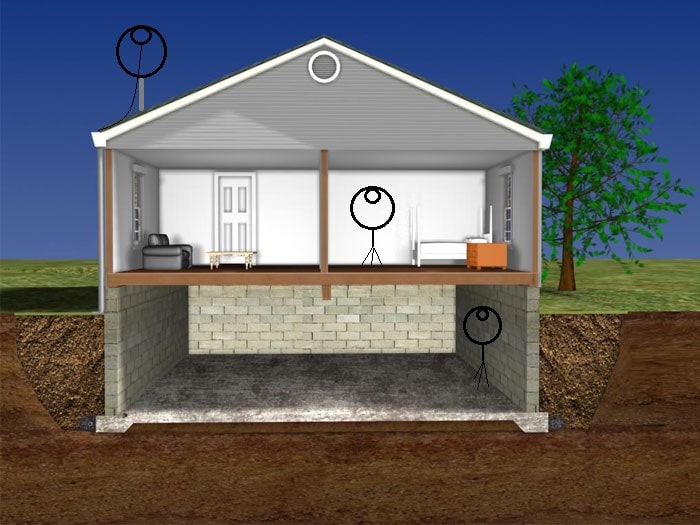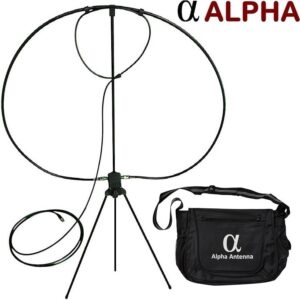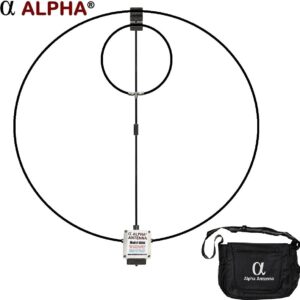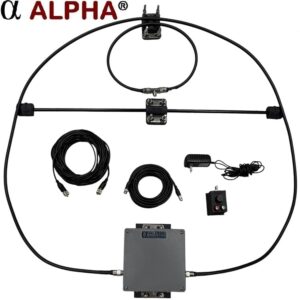Introduction
Amateur radio enthusiasts and shortwave listeners often find themselves exploring various antenna options to optimize signal reception and transmission. One such option is the magnetic loop antenna, known for its compact size and impressive performance on certain frequencies. However, the effectiveness of this antenna can vary depending on its placement. For example, even in homes with stucco that has been applied over ‘chicken wire’, this antenna can prove to be functional, albeit with reduced efficiency. With that in mind, we will compare the use of a magnetic loop antenna in a basement, indoors, and outdoors, highlighting the advantages and disadvantages of each scenario.
QUICK TIP – If you think your antenna isn’t working, check band conditions at QRZ.com and then take your antenna outdoors if conditions are good.
The Magnetic Loop Antenna: A Brief Overview
A magnetic loop antenna is a compact, loop-shaped antenna primarily used for receiving and transmitting signals in the high-frequency (HF) and very high-frequency (VHF) ranges. It consists of a loop of wire and a tuning capacitor, creating a resonant circuit that effectively captures and sends electromagnetic waves. Due to its small size, the magnetic loop antenna is a popular choice for those with limited space for larger conventional antennas.
Basement Installation
Using a magnetic loop antenna in a basement can present certain challenges and benefits. Basements are most often shielded by the building’s structure and can be surrounded by electrical and metallic elements. This shielding can both help and hinder signal reception. On the positive side, the basement’s shielding may reduce local interference and electrical noise, leading to clearer signals. However, the proximity to large metal objects, or even the basement’s walls themselves, might also impact the antenna’s tuning and overall performance. Additionally, some basements use rebar during construction, and some do not. The Faraday shielded structures, which are those with rebar, do not allow much RF to penetrate that particular type of structure. So, your experiences may vary based upon structural content. Set your expectations for this category to mainly NVIS, but not good groundwave or DX results.
Indoor (non-subterranean) Installation
Indoor usage of a magnetic loop antenna on the main floor of a structure offers more effectiveness compared to a basement setup. Placing the antenna here allows for greater control over its surroundings. The antenna can be positioned away from significant sources of interference and noise, potentially leading to improved reception quality and increased effective transmissions. However, indoor installations may still be affected by walls, electronic devices, and wiring, which can introduce unwanted reflections and attenuate signals. So again, your experiences may vary based upon structural content. Reports show that signals inside of a standard stick-built house lowers signal strength on both receive & transmit by approximately 2 S-Units. This still enables some DX to occur. Set your expectations for this category to mainly NVIS with limited DX, but not good groundwave or constant DX results.
Outdoor Installation
Using a magnetic loop antenna outdoors is often considered the ideal scenario for maximizing its performance. Outdoors, the antenna is less likely to encounter obstructions that could impede signal reception and transmission. It can be set up in an open area, away from buildings and large metal structures, minimizing potential sources of interference. This setup optimizes the antenna’s ability to capture weak signals and reduces the impact of reflections. Additionally, the antenna’s efficiency in radiating signals is enhanced outdoors. So, set your expectations for this category to be most effective for NVIS, good groundwave, or DX results.
Comparative Analysis
- Signal Quality: Outdoors is generally superior in terms of signal quality due to minimal obstructions and reduced interference. Indoors and basements might suffer from reflections and interference from electronic devices.
- Noise Level: Basements might experience the lowest noise due to natural shielding, followed by indoors. Outdoors can have higher noise levels from environmental factors like power lines and radiofrequency interference.
- Ease of Installation: Indoors is the simplest setup, while basements and outdoors may require more careful placement.
- Space Requirements: The compact nature of magnetic loop antennas is well-suited for indoor and basement installations where space is limited. Outdoors offers more freedom in positioning.
- Interference: Basements and indoors can benefit from reduced interference due to shielding, but this can also limit the antenna’s effectiveness. Outdoors minimizes potential interference sources generated by home appliances.
- Weather Considerations: Outdoor installations are susceptible to weather conditions, which might necessitate protective measures, for which the base Alpha Loop antenna is recommended. Indoor and basement setups are immune to weather-related issues, and the portable Alpha Loop antenna is recommended.
Conclusion
In conclusion, the choice of using a magnetic loop antenna in a basement, indoors, or outdoors depends on the trade-offs that align with your specific requirements. Basements provide natural shielding but might encounter tuning issues. Indoors offer controlled environments with potential for interference. Outdoors, while ideal for signal quality, can be affected by weather and other outdoor factors. Understanding these factors will help you make an informed decision about the selection and optimal placement of your magnetic loop antenna, ensuring you get the best performance based on your circumstances and preferences.
-
VHF UHF HF Antenna (EmComm MagLoop)$399.00Rated 4.99 out of 5 based on 99 customer ratings
-
10-40M 100W (HF MagLoop) optional VHF UHF 6M or 60/80M$550.00Rated 5.00 out of 5 based on 92 customer ratings
-
100W 10-40M Remote Tune (Base MagLoop)$999.00Rated 5.00 out of 5 based on 9 customer ratings




